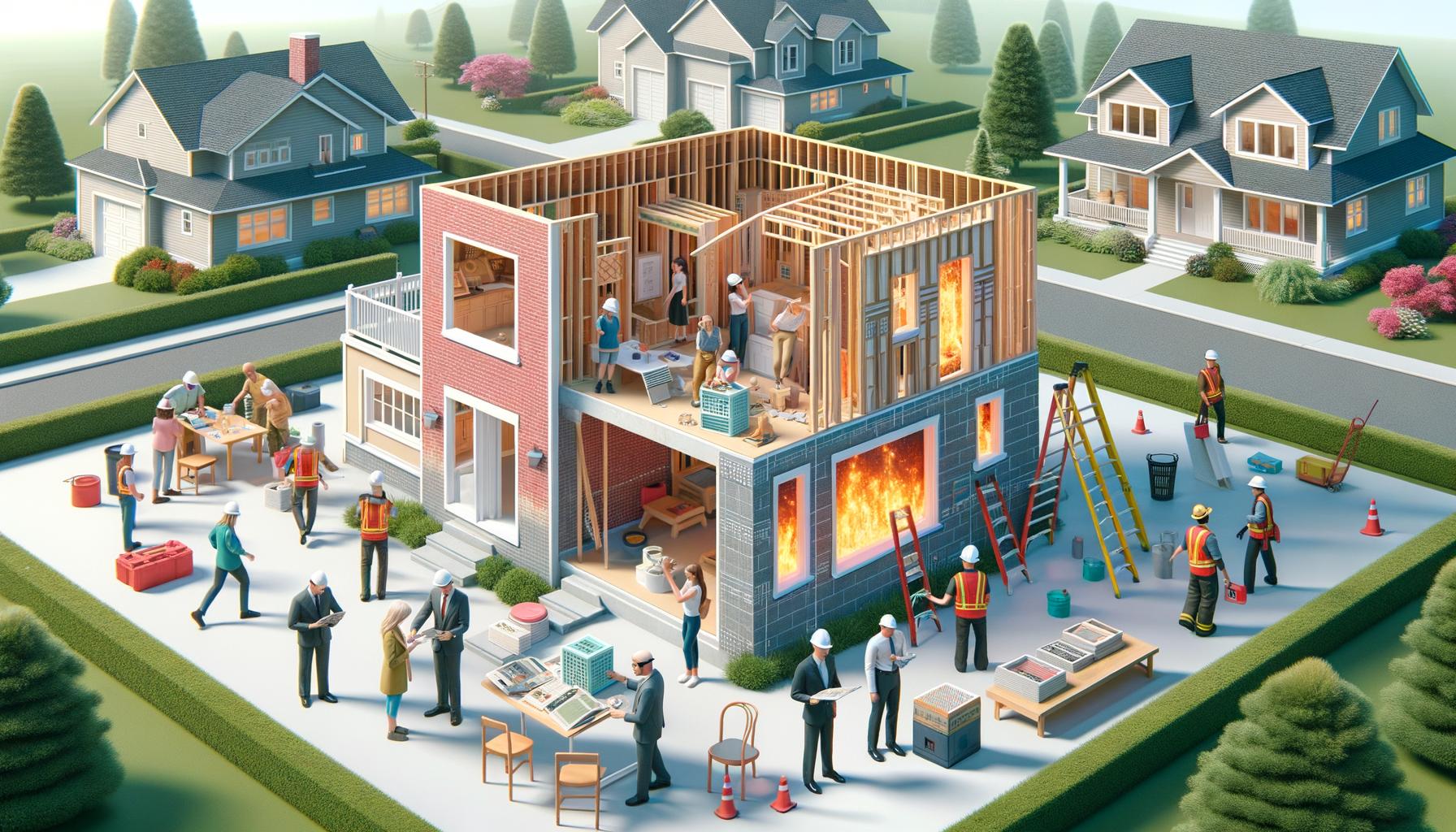
At Home Owners Association, we understand the critical importance of fire safety in residential buildings.
Fireproof building materials play a vital role in protecting homes and lives from the devastating effects of fires.
This blog post explores the various types of fire-resistant materials available for construction and renovation, their benefits, and how to incorporate them effectively into your home.
What Are Fireproof Building Materials?
The Science of Fire Resistance
Fireproof building materials are essential components in modern construction. These materials resist or slow the spread of fire, protecting lives and property during emergencies. Fire-resistant materials maintain their structural integrity under high temperatures, often for several hours. This property allows occupants more time to evacuate and gives firefighters a better chance to control the blaze.
Common Types of Fireproof Materials
Concrete stands out as one of the most widely used fire-resistant materials. It withstands temperatures up to 1000°C for about an hour before losing strength. Gypsum board (also known as drywall) is another popular choice. Its noncombustible core slows heat transfer, which prevents fire spread effectively.
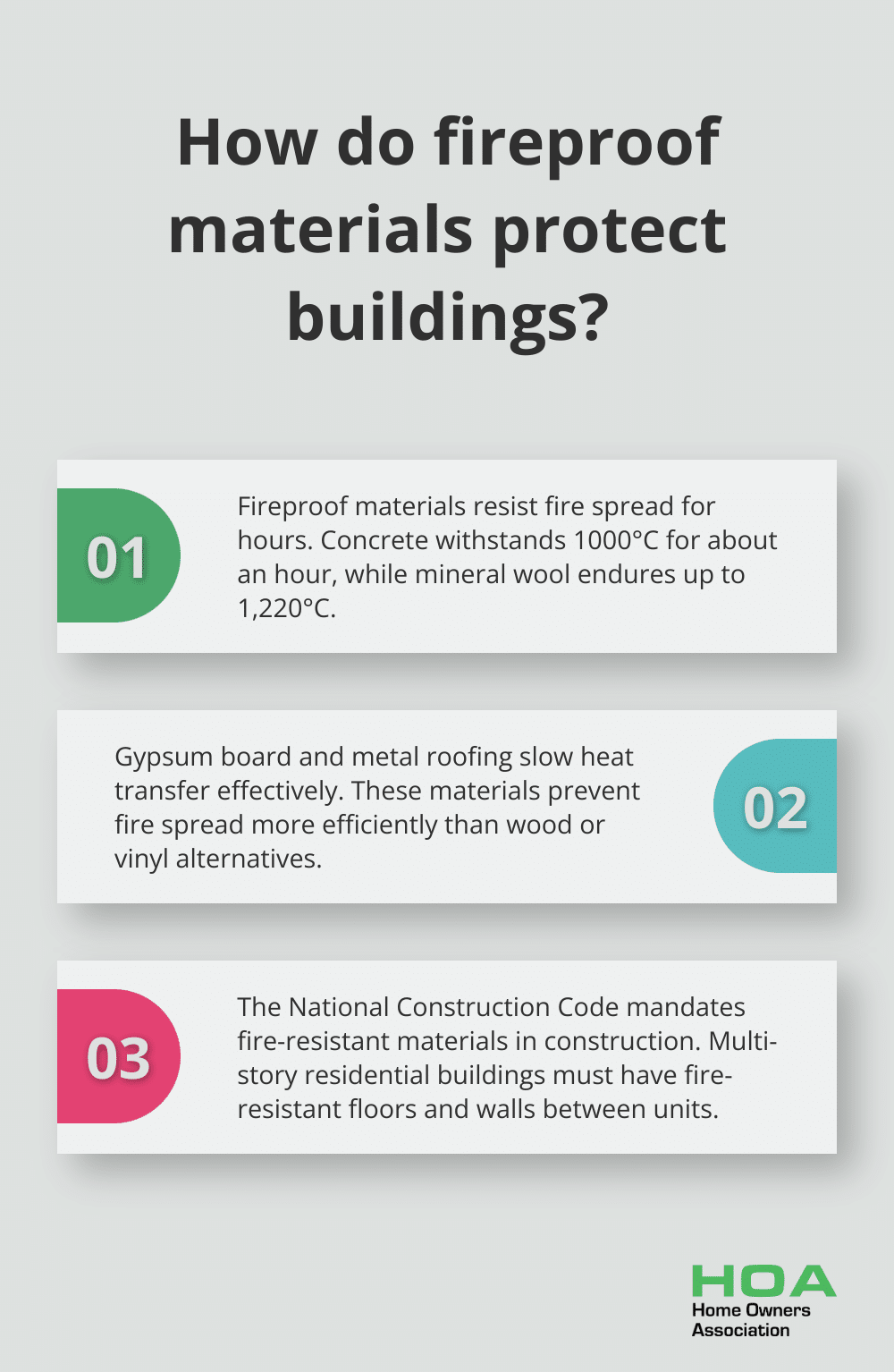
For insulation, mineral wool proves an excellent option. It endures temperatures up to 1,220°C, significantly higher than traditional fiberglass insulation. Metal roofing and siding materials (particularly those made from steel or aluminum) offer superior fire resistance compared to wood or vinyl alternatives.
Building Codes and Fire Safety Regulations
Building codes across Australia have strict requirements for fire-resistant materials in construction. The National Construction Code (NCC) sets out specific standards for different building types and occupancies. For example, multi-story residential buildings must have fire-resistant floors and walls between units to prevent fire spread.
Homeowners must understand these regulations when they plan renovations or new constructions. Failure to comply with fire safety codes can result in hefty fines and, more importantly, put lives at risk. (Home Owners Association members can access expert advice on navigating these complex regulations, ensuring their projects meet all necessary standards.)
The Long-Term Benefits of Fire-Resistant Materials
The initial cost of fire-resistant materials may be higher, but the long-term benefits are substantial. Insurance companies often offer lower premiums for homes built with these materials, recognizing their reduced risk. Moreover, fire-resistant homes typically have higher resale values, making them a wise investment for homeowners.
In bushfire-prone areas, the use of non-flammable building materials can significantly increase a home’s chances of survival.
Future Trends in Fireproof Materials
As we face increasing fire risks due to climate change, the importance of fireproof building materials continues to grow. Researchers and manufacturers are developing new, innovative materials that offer even better fire resistance. These advancements promise to revolutionize the construction industry and further enhance home safety in the coming years.
The next chapter will explore the top fireproof building materials for homes, providing practical insights for homeowners who want to enhance their property’s fire safety.
Best Fireproof Materials for Your Home
Concrete: The Gold Standard in Fire Resistance
Concrete’s fire resistance is determined by calculation based on the performance of a prototype in the Standard Fire Test and confirmed in a report in accordance with Clause 3. Its fire resistance rating can extend up to four hours, depending on thickness and composition. A 100mm thick reinforced concrete wall can achieve a fire-resistance level (FRL) of 240/240/240, which means it maintains structural adequacy, integrity, and insulation for 240 minutes during a standard fire test.
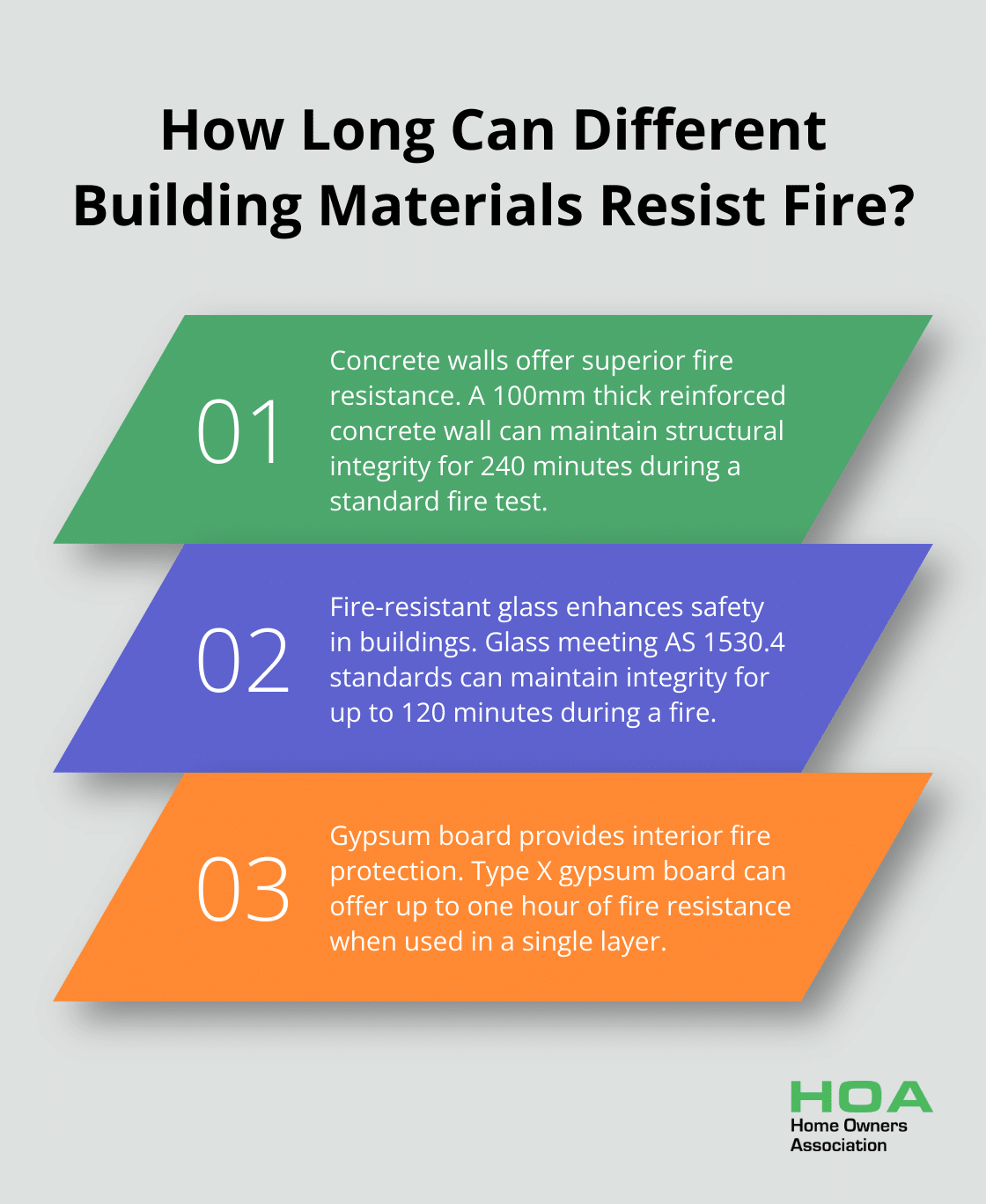
Precast concrete panels have gained popularity in residential construction due to their superior fire resistance and quick installation. Manufacturers produce these panels off-site, allowing for rapid erection and top-notch fire safety.
Fire-Resistant Glass: A Clear Choice for Safety
Glass technology advancements have produced products that withstand intense heat for extended periods. Fire-resistant glass, such as those meeting AS 1530.4 standards, can maintain integrity for up to 120 minutes during a fire. This provides occupants extra time to evacuate and firefighters more opportunity to control the blaze.
Dual-paned and tempered glass windows excel at enhancing fire safety. These windows resist breakage longer than regular glass, which helps contain fires and prevent their spread. (For areas prone to bushfires, metal shutters over windows offer added protection against radiant heat and flying debris.)
Metal Roofing: Top-Tier Protection from Above
Metal roofing, particularly steel and aluminum, offers fire resistance. The fire resistance levels for various building elements, including roofing, are determined through specific techniques and data as outlined in FCRC Project 3.
When selecting metal roofing, try to choose products with a Class A fire rating, the highest classification available. These materials can withstand severe fire exposure without allowing the fire to spread to the attic space.
Gypsum-Based Materials: Interior Defense Against Fire
Gypsum board, commonly known as drywall, plays a vital role in fire-resistant construction. Type X gypsum board, which contains glass fibers and other additives, can provide up to one hour of fire resistance when used in a single layer. For enhanced protection, multiple layers or specialized fire-rated gypsum products offer even greater safety.
Fire-resistant steel coatings have improved building safety, while new welding techniques have enhanced joint strength. These innovations allow for more effective use of gypsum-based materials in fire-resistant construction.
The incorporation of these fire-resistant materials into home construction or renovation projects significantly enhances property safety. (While the initial cost may be higher, the long-term benefits in terms of safety and potential insurance savings prove substantial.) The next chapter will explore how to effectively incorporate these fireproof materials into your home construction and renovation projects.
How to Fireproof Your Home
Prioritize High-Risk Areas
The roof stands as a prime target for flying embers during bushfires. Replace traditional roofing with metal options to boost your home’s fire resistance significantly. A study found that buildings with a higher Wildfire Resistance Index (WRI) had a better survival rate, with 65% of California buildings with WRI = 1 being destroyed, compared to an average of 85% for WRI ≥−0.33.
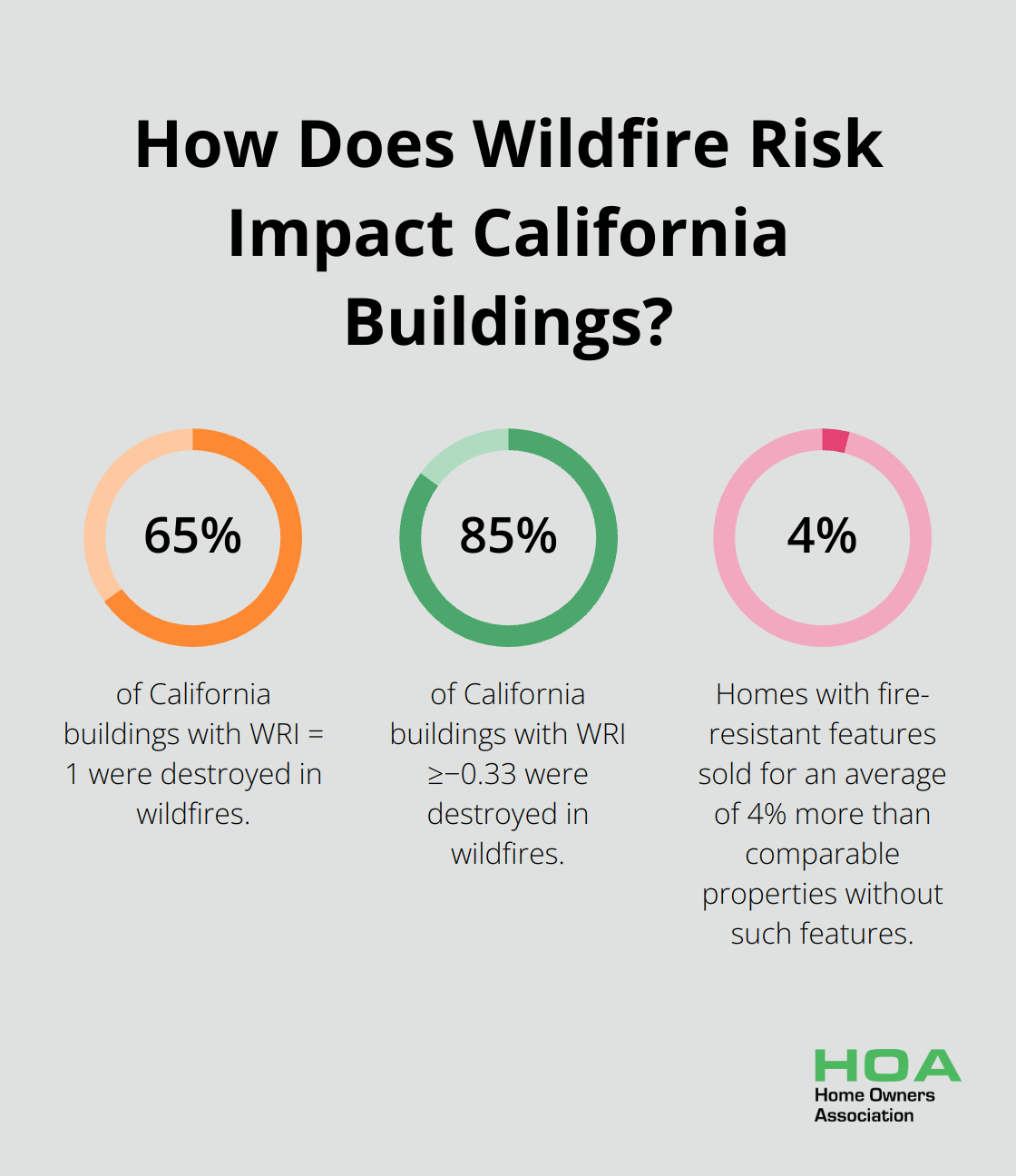
Walls require equal attention. When building or renovating, use fire-resistant gypsum board. A single layer of 5/8-inch Type X gypsum board provides up to one hour of fire resistance. For enhanced protection, install two layers to increase fire resistance up to four hours.
Retrofit for Fire Safety
Existing homes can incorporate fire-resistant materials without a complete overhaul. Apply intumescent paint to structural elements as an effective method. This special coating expands when exposed to heat, creating a protective barrier. Recent research has investigated the effectiveness of intumescent coatings on steel tension members with circular solid and hollow sections in real-scale fire tests.
Upgrade your windows as another simple yet effective retrofit. Install dual-paned or tempered glass windows to slow fire spread significantly. These windows resist breakage under extreme heat longer, allowing extra minutes for evacuation or firefighting efforts.
Cost-Effective Fire Protection
Fireproofing proves cost-effective in the long run, despite initial expenses. Insurance companies often offer discounts for homes with fire-resistant features.
Fireproofing can also increase your property value. The National Association of Home Builders found that homes with fire-resistant features sold for an average of 4% more than comparable properties without such features.
Select Quality Materials
Choose fire-resistant materials carefully to ensure maximum protection. Try to select products with a Class A fire rating, the highest classification available. These materials withstand severe fire exposure without allowing fire to spread.
Consult with Experts
Seek advice from fire safety professionals to develop a comprehensive fireproofing strategy for your home. These experts can assess your property’s specific risks and recommend tailored solutions. Their knowledge ensures that your fireproofing efforts comply with local building codes and regulations.
Final Thoughts
Fireproof building materials are essential for modern home safety. These materials offer critical protection, provide extra time for evacuation, and can save lives and property. The initial cost of fire-resistant options may be higher, but the long-term benefits outweigh the expense through enhanced safety and potential insurance savings.
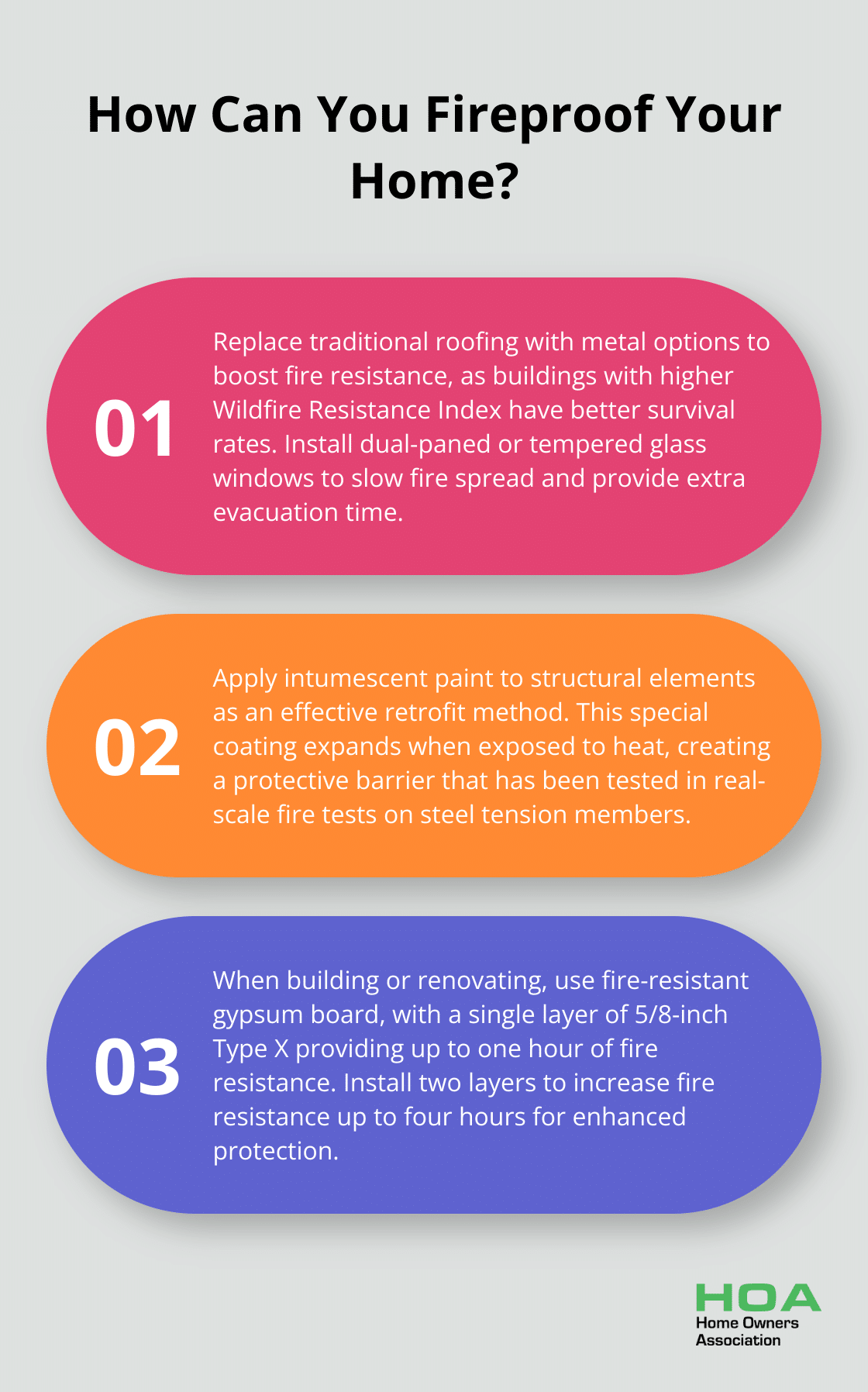
We at Home Owners Association support Melbourne homeowners in creating safer living spaces. Our members receive expert advice and access to trade pricing on fire-resistant materials. Local fire departments and building professionals can also offer valuable guidance for those looking to improve their home’s fire resistance.
Incorporating fireproof building materials is an ongoing process that requires staying informed about new technologies and products. (As fire risks increase, prioritizing fire resistance in our homes not only protects our families but also contributes to safer communities overall.) We encourage homeowners to take proactive steps in enhancing their property’s fire safety.





